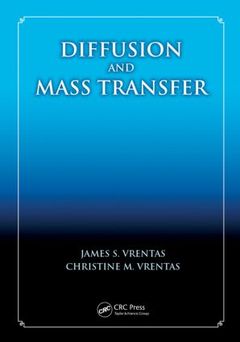Description
Diffusion and Mass Transfer
Authors: Vrentas James S., Vrentas Christine M.
Language: English
Subjects for Diffusion and Mass Transfer:
Keywords
Parabolic PDE; Mutual Diffusion Coefficient; Mass Transfer; Finite Difference Method; PolymerSolvent Behavior; Independent Constitutive Variable; Diffusion; Mass Fraction Gradient; Free-Volume Theory; Bubble Dissolution; GreenS Function Methods; SCE; Ordinary Differential Equation; Exponential Fourier Transform; Mass Diffusion Flux; American Chemical Society; Green’s Function Problem; Hole Free Volume; Polymer Solvent Systems; Sturm Liouville Problem; Mass Transfer Problems; Partial Specific Volumes; Green’s Function; Sorption Curves; Sorption Experiments; Laplace Transform; Material Time Derivatives; Frame Indifferent; Constitutive Equations; Copyright Wiley VCH Verlag GmbH
172.36 €
In Print (Delivery period: 15 days).
Add to cartSupport: Print on demand
Description
/li>Contents
/li>Biography
/li>
A proper understanding of diffusion and mass transfer theory is critical for obtaining correct solutions to many transport problems. Diffusion and Mass Transfer presents a comprehensive summary of the theoretical aspects of diffusion and mass transfer and applies that theory to obtain detailed solutions for a large number of important problems. Particular attention is paid to various aspects of polymer behavior, including polymer diffusion, sorption in polymers, and volumetric behavior of polymer?solvent systems.
The book first covers the five elements necessary to formulate and solve mass transfer problems, that is, conservation laws and field equations, boundary conditions, constitutive equations, parameters in constitutive equations, and mathematical methods that can be used to solve the partial differential equations commonly encountered in mass transfer problems. Jump balances, Green?s function solution methods, and the free-volume theory for the prediction of self-diffusion coefficients for polymer?solvent systems are among the topics covered. The authors then use those elements to analyze a wide variety of mass transfer problems, including bubble dissolution, polymer sorption and desorption, dispersion, impurity migration in plastic containers, and utilization of polymers in drug delivery. The text offers detailed solutions, along with some theoretical aspects, for numerous processes including viscoelastic diffusion, moving boundary problems, diffusion and reaction, membrane transport, wave behavior, sedimentation, drying of polymer films, and chromatography.
Presenting diffusion and mass transfer from both engineering and fundamental science perspectives, this book can be used as a text for a graduate-level course as well as a reference text for research in diffusion and mass transfer. The book includes mass transfer effects in polymers, which are very important in many industrial processes. The attention given to the proper setup of numerous problems along with the explanations and use of mathematical solution methods will help readers in properly analyzing mass transfer problems.
Introduction. Conservation Laws and Field Equations. Boundary Conditions. Constitutive Equations. Parameters in Constitutive Equations. Special Behaviors of Polymer–Penetrant Systems. Mathematical Apparatus. Solution Strategy for Mass Transfer Problems. Solutions of a General Set of Mass Transfer Problems. Perturbation Solutions of Mass Transfer Moving Boundary Problems. Diffusion and Reaction. Transport in Nonporous Membranes. Analysis of Sorption and Desorption. Dispersion and Chromatography. Effects of Pressure Gradients on Diffusion: Wave Behavior and Sedimentation. Viscoelastic Diffusion. Transport with Moving Reference Frames. Appendix: Vector and Tensor Notation.
James S. Vrentas received his B.S. degree in chemical engineering from the University of Illinois and his M.Ch.E. and Ph.D. degrees in chemical engineering from the University of Delaware. As the Dow Professor of Chemical Engineering at the Pennsylvania State University, he teaches and conducts research in the fundamental aspects of diffusion and fluid mechanics. He is the recipient of two national AIChE awards, the William H. Walker Award for Excellence in Contributions to the Chemical Engineering Literature and the Charles M. A. Stine Award for Materials Engineering and Science. At Penn State, he has received the College of Engineering’s Premier Research Award and several teaching awards.
Christine M. Vrentasreceived her B.S. degree in chemical engineering from the Illinois Institute of Technology and her M.S. and Ph.D. degrees in chemical engineering from Northwestern University where she studied the dynamic and transient properties of polymer solutions. She has served as an instructor at the Pennsylvania State University and is currently an adjunct professor in the chemical engineering department working in the areas of diffusion and fluid mechanics. As a public school volunteer and supporter of science education, she helped coach State College Area Middle and High School Science Olympiad teams to national gold medals and served as a regional and state event supervisor at Science Olympiad competitions.
These books may interest you

Introduction to Polymers 220.72 €



